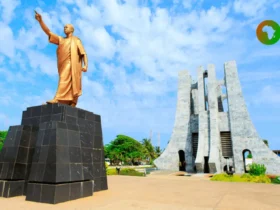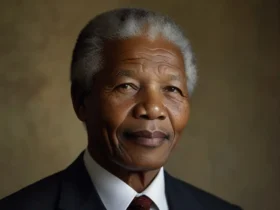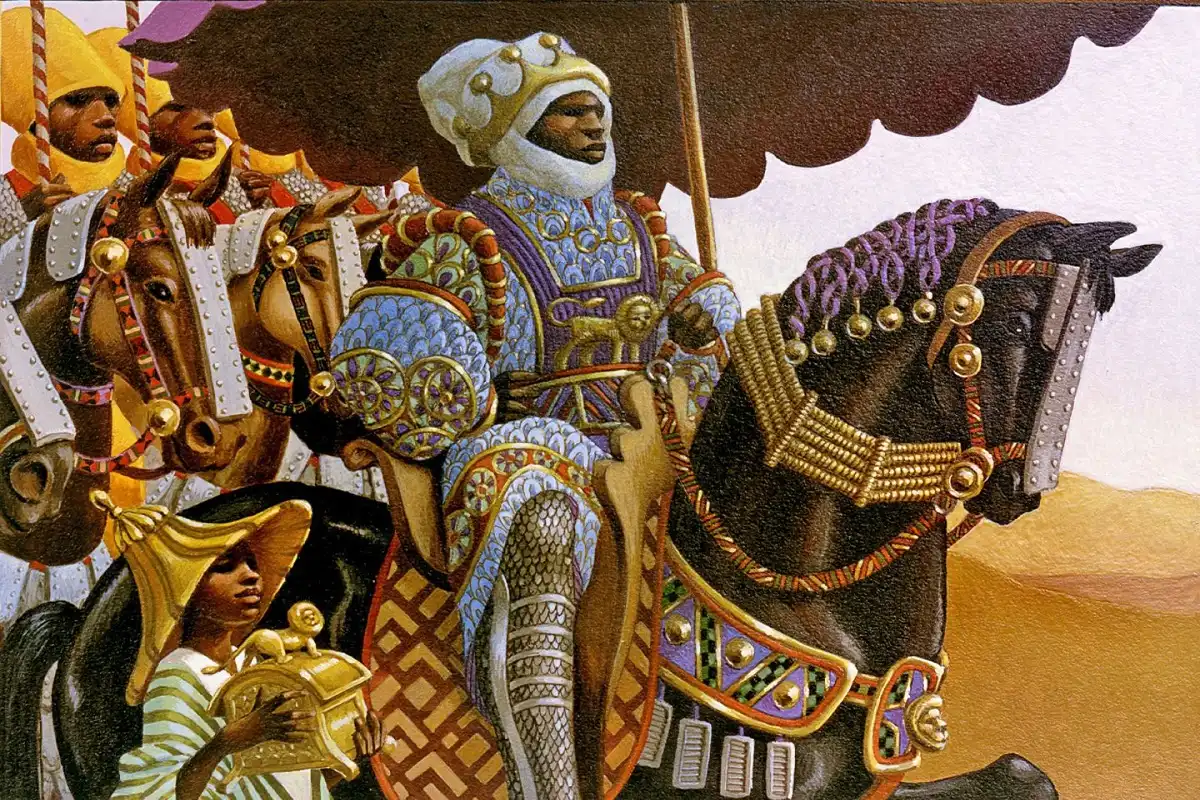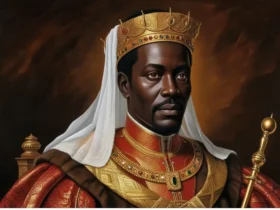Mansa Musa I, also known as Musa Keita I, was the tenth ruler of the Mali Empire, reigning from 1312 to 1337 CE. Widely considered one of the wealthiest individuals in history, Mansa Musa’s legacy extends beyond his wealth to his contributions to culture, education, and religion. Under his leadership, the Mali Empire reached its zenith, becoming a hub for trade, learning, and Islamic culture in West Africa.
Early Life and Ascension to Power
- Musa Keita was born into the Keita dynasty, which traced its lineage to the founder of the Mali Empire, Sundiata Keita. Little is known about his early life, but he likely grew up in an environment of relative privilege and military training, as was customary for the ruling elite.
- Musa’s ascension to the throne was somewhat serendipitous. Before becoming emperor, he served as the deputy ruler (kankoro-sigui) under his predecessor, Abu Bakr II. Abu Bakr, fascinated by the Atlantic Ocean, allegedly embarked on an ambitious voyage to explore its western expanse with a fleet of ships. He never returned, leaving Musa to assume the role of emperor.
- In 1312, Musa officially became Mansa (king of kings). At the time, Mali was already a prominent West African power, but Musa’s reign would elevate it to unprecedented heights.
The Expansion of the Mali Empire
- Under Mansa Musa, the Mali Empire expanded significantly, encompassing vast territories across West Africa. The empire stretched from the Atlantic coast to the Niger River and included parts of present-day Senegal, Mauritania, Mali, Burkina Faso, Niger, Guinea, and the Ivory Coast.
- Musa’s military campaigns consolidated Mali’s control over important trade routes, particularly those involving the trans-Saharan trade of gold, salt, and other commodities. This trade network connected West Africa to North Africa and the Mediterranean, making Mali a crucial economic player.
The Famous Pilgrimage to Mecca (1324-1325)
- One of the most famous episodes of Mansa Musa’s reign was his pilgrimage (hajj) to Mecca in 1324-1325. As a devout Muslim, Musa undertook the hajj to fulfill one of the Five Pillars of Islam. However, this was no ordinary pilgrimage.
- Musa traveled with a caravan of unprecedented size and opulence. Historical accounts describe his entourage as including tens of thousands of people, hundreds of camels, and vast quantities of gold. Musa’s generosity and wealth were on full display as he distributed gold freely to the poor, built mosques along the way, and traded extensively with local populations.
- In Cairo, one of the major stops on his journey, Musa’s lavish spending disrupted the local economy. The sudden influx of gold devalued the metal, causing inflation that reportedly took years to stabilize. This event is often cited as evidence of his immense wealth and the economic power of the Mali Empire.
Cultural and Religious Contributions
Mansa Musa was a staunch supporter of Islam, and his reign is marked by significant cultural and religious advancements. Upon returning from Mecca, he brought back Islamic scholars, architects, and artisans to Mali. These individuals played a crucial role in transforming cities like Timbuktu and Gao into centers of learning and culture.
Timbuktu and the Sankore University
Timbuktu, already a trading hub, became a center for Islamic scholarship under Musa’s patronage. He commissioned the construction of the famous Sankore Mosque and its associated university. The university attracted scholars from across the Islamic world and housed a vast collection of manuscripts, making Timbuktu one of the intellectual capitals of the medieval world.
Architectural Achievements
- Mansa Musa’s reign saw the construction of numerous mosques and palaces. He is credited with building the Djinguereber Mosque in Timbuktu, designed by Andalusian architect Abu Ishaq al-Sahili, whom Musa reportedly brought back from his pilgrimage.
- These architectural projects not only symbolized Mali’s wealth and devotion to Islam but also contributed to the empire’s lasting cultural legacy.
Economic Policies and Wealth
The Mali Empire’s prosperity during Musa’s reign was largely based on its vast natural resources, particularly gold. At the time, Mali was one of the largest producers of gold in the world, and this wealth fueled its economy and Musa’s reputation.
Mansa Musa’s economic policies included:
- Control of Trade Routes: By securing trans-Saharan trade routes, he ensured the steady flow of goods and resources into and out of Mali.
- Standardization of Weights and Measures: This facilitated fair trade practices and boosted commerce.
- Investment in Infrastructure: Musa’s projects, including roads and public buildings, supported economic growth and integration across the empire.
Legacy of Mansa Musa
- Mansa Musa’s reign left an indelible mark on West Africa and the world. His contributions to the spread of Islam, the promotion of education, and the cultural development of Mali cemented his legacy as one of history’s greatest rulers.
Global Recognition
- Mansa Musa’s fame spread far and wide, largely due to his pilgrimage. He was featured in the Catalan Atlas of 1375, a major medieval European map, depicted holding a gold nugget. This representation underscored his reputation as a fabulously wealthy ruler and brought Mali to the attention of the broader world.
Posthumous Influence
- After Musa’s death in 1337, the Mali Empire continued to thrive for several decades. However, internal strife and external pressures eventually led to its decline. Despite this, Mansa Musa’s legacy endured through the cultural and educational institutions he established.
Modern Recognition
- In recent years, Mansa Musa has been celebrated as a symbol of African achievement and potential. His story is often cited as an example of Africa’s historical contributions to global civilization.
The Impact of Mansa Musa’s Wealth and Influence
- Mansa Musa’s wealth was derived primarily from the Mali Empire’s vast reserves of gold. It is said that he controlled nearly half of the world’s gold supply at the time. Gold was mined in the region of Bambuk, which was the heart of Mali’s gold trade. The empire’s wealth allowed Mansa Musa to fund public works, infrastructure, and religious institutions on an unprecedented scale.
- One of the most lasting impacts of Mansa Musa’s reign was his patronage of architecture and education. Upon returning from his pilgrimage to Mecca, Mansa Musa invested heavily in the construction of mosques, schools, and other architectural projects, transforming the cultural landscape of the empire.
- He commissioned the construction of the famous Djinguereber Mosque in Timbuktu, which remains a UNESCO World Heritage Site to this day. This mosque became a center of learning and religious practice, attracting scholars from across the Muslim world. The city of Timbuktu itself grew into a renowned center of education, with Mansa Musa establishing institutions of higher learning and inviting scholars, poets, and scientists to the empire.
- Mansa Musa’s investment in education helped elevate Mali as a cultural and intellectual hub. Timbuktu became home to one of the most famous universities of the time, the Sankore Madrasah, which drew scholars from as far as Morocco, Egypt, and the Middle East. The city’s libraries housed thousands of manuscripts on subjects ranging from science and mathematics to philosophy and theology.
- In addition to his patronage of education and architecture, Mansa Musa also promoted Islamic scholarship. His rule helped to integrate Mali more fully into the broader Islamic world, and his embrace of Islam helped solidify Mali’s status as a powerful Islamic state in West Africa.
- The Decline of Mansa Musa’s Empire
- After Mansa Musa’s death in 1337, the Mali Empire began a slow decline, though it remained a powerful state for several centuries after his reign. His successors, though capable rulers, were unable to maintain the same level of unity and control that Mansa Musa had. Several factors contributed to the decline, including internal conflicts, external invasions, and the gradual loss of Mali’s gold trade dominance as new gold sources were discovered elsewhere.
- Additionally, the empire’s vast size made it difficult to govern effectively, leading to the fragmentation of its territories. In particular, the empire’s eastern territories, including the important trade routes to the north, became vulnerable to attack from neighboring states.
- Despite these challenges, Mali remained an important center of trade and culture in West Africa for generations, even after the decline of Mansa Musa’s direct descendants. The legacy of Mansa Musa, however, remained intact. His name continued to evoke awe throughout Africa and the Islamic world, and the Mali Empire’s accomplishments in architecture, education, and commerce had a lasting influence on the history of the region.
Mansa Musa’s Legacy
- Mansa Musa’s legacy endures in many ways. He is often remembered as one of the wealthiest individuals in history, with his name and image appearing in various historical texts, including the famous Catalan Atlas, a medieval map where he is depicted as a regal figure with a gold scepter. His journey to Mecca, with its lavish display of wealth, remains one of the most remarkable episodes in world history, and it significantly changed perceptions of Africa and its role in global affairs.
- Moreover, Mansa Musa’s contributions to the spread of Islam in West Africa helped shape the religious landscape of the region, which remains predominantly Muslim to this day. His patronage of education and culture in Mali led to the rise of Timbuktu as a world-renowned center of learning, and the legacy of Islamic scholarship continues to influence the region.
- Though much of the material wealth Mansa Musa accumulated was eventually lost to history, his empire’s contributions to African civilization continue to inspire pride and respect in the global imagination. The grandeur of his reign, the extraordinary wealth of the Mali Empire, and the intellectual achievements he fostered have solidified Mansa Musa’s status as a monumental figure in African and world history.
Conclusion
- Mansa Musa’s life and reign encapsulate the zenith of the Mali Empire’s power and influence. As a ruler, he combined economic acumen with a commitment to culture and religion, transforming Mali into a beacon of wealth, learning, and Islamic culture. His pilgrimage to Mecca and subsequent contributions to Islamic scholarship and architecture remain defining aspects of his legacy.
- Today, Mansa Musa is remembered not just as a wealthy king but as a transformative leader whose impact continues to inspire and educate.































